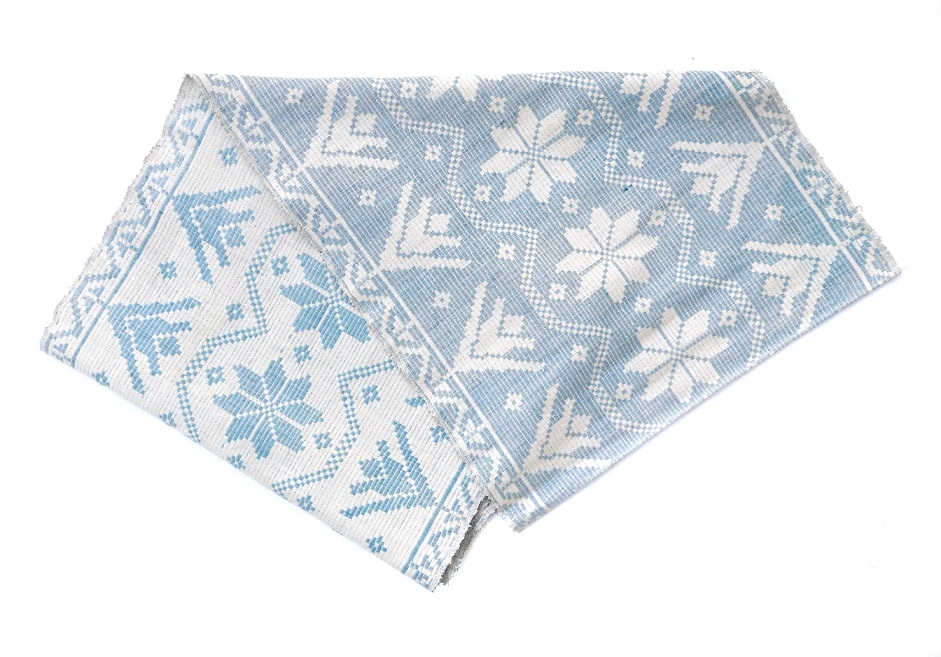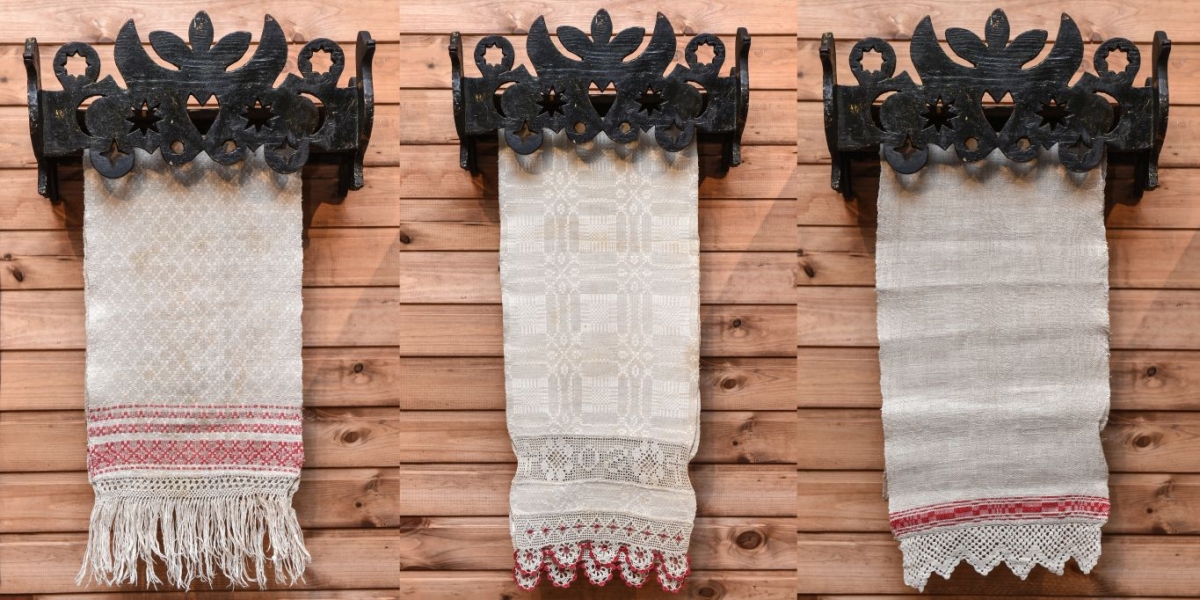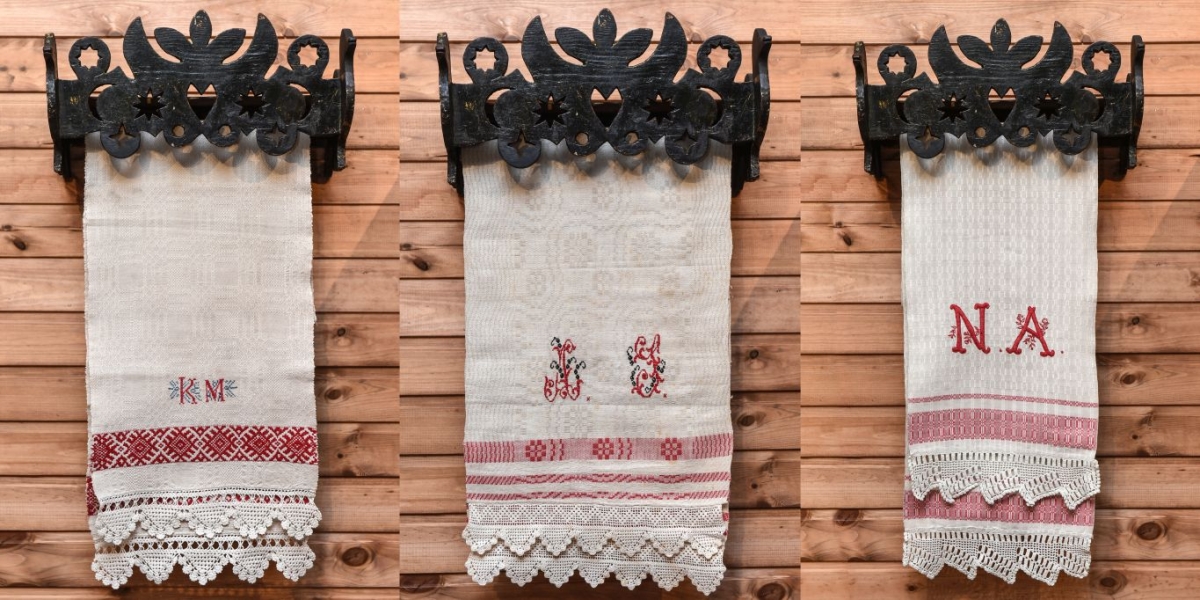
Joint virtual monthly exhibition. March – “Towels”

Preili Museum of History and Applied Arts (Latvia), Grodno State Museum of the History of Religion (Belarus) and Panevezys Local Lore Museum (Lithuania) joint virtual exhibition – “Towels”.
Preili Museum of History and Applied Arts
The collection of the Preili Museum of History and Applied Arts contains 82 towels, which chronologically cover the period from the end of the 19th century till the 1990’s. The oldest towel was made around 1890 in Rusecki village, Ludza district. The latest towels are made in 1986 in Līvāni by members of the Applied Art Studio "Dubna".
Divided by functional use, there are honorary (festive, celebrations and guest towels), casual (mouth and hand wipes) and kitchen towels. The towels were an integral part of the dowry of brides and they were woven, embroidered and variously decorated to prove the makers excellent abilities and good taste. Towels decorated with Art Nouveau floral arrangements are the most widely represented in the museum collection.
One of the most popular towel end decorations in the museum's towel collection is crochet lace. Embroidery is also widely used to decorate towels. They were made by the women of the region, following the fashion trends of the era. The ends of the towels were decorated with floral compositions embroidered with colored threads, supplemented with text, monograms, motifs of foreign folklore. The towels decorated with the pull-out (open work) technique are especially luxurious and sophisticated.
1. The oldest towels in the collection of Preili Museum of History and Applied Arts. The end of the 19th century. The oldest towel was woven in the 1890s in the village of Rusecki in a patterned three-nite technique. Embroidered in Preili in 1953. The second oldest towel is from the end of the 19th century. The towel is woven in three-nite pattern from linen, the ends are crochet cotton lace with a stylized bird pattern. One end of the towel is embroidered with red flowers with green leaves and the inscription in red “Wipe your mouth And remember me”. At the other end – embroidered two birds in red, floral motif, under it a monogram in red "AP".

2. White towels by Eleonora Reča. 1930–1940’s. Especially fine are the white towels made by the weaver Elonora Reča from Babri, Silajāņi parish, Rēzekne district, in the 1930–1940’s. The ends of the towels are decorated with both crochet lace and embroidery by open work with stripes, floral and leaf motifs.

3. Towel decorated with embroidered floral composition and text. 1960’s. Starting from the beginning of the 20th century towels with embroidered text appear - wishes, folk songs, patriotic verses. It was possible to buy embroidery patterns in handicraft shops. Valentina Vaivode's hand towel made in the 1960s in Kivlenieki, Rudzāti parish stands out with especially rich embroidery. One end of the towel is decorated with a red-colored stylized flower, green leaf motif and a blue inscription “Life is a dream. Ideal – is not real”. A short folk song text embroidered in dark red on the other end of the towel.

Grodno State Museum of the History of Religion
Ethnographic towels. Belarusian towel (embroidered ritual towel) is a faithful companion of a person that accompanied him or her throughout the whole life for many centuries. It unveiled a whole world of images, events, beliefs and destinies of many generations of Belarusians. The midwife used a towel to accept the baby, the towels were taken when asking in marriage, and the newlyweds stood on the towel in the church. The towels were used to carry the dead out of the house, then bring the dead to the cemetery and put him/her into the grave. In addition, the towel accompanied a person in everyday activities from morning to late evening. Therefore, towels are one of the most interesting phenomena of traditional Belarusian culture. The collection of the Grodno State Museum of the History of Religion contains a large number of ethnographic towels of various types. Let's get more information about them.
1. Religious towel. Icon towel by Maryya Stsepunenka. Prapoysk District. 1920s. Religious towel was endowed with the highest status, because it was intended to be used to decorate icons since ancient times. In this regard, it is ornamented not only along the edges, but also in the middle. It was created at the beginning of the 20th century on the territory of the Mahilioŭ province.

2. Wedding towel. Towel of matchmaker by Nina Matsulevič. Drahičyn district. 1920s-1930s. The towel played an important role at weddings. In the old days, a girl of marriageable age, together with the older women in the family, embroidered at least 30 towels specially for the wedding. The important participants in the celebration – the mother of the groom, the mother of the bride, matchmakers were tied up with the towels. During the wedding, the newlyweds stood on the towel. All these rites symbolized the unification of the two clans. Some of the rituals have survived to this day.

3. Funeral (mourning) towel. Towel of mourning by Maryya Matskala. Lida district. 1950. In funeral rites, the towel symbolized the road to another world. In villages, it was customary to hang a towel out when someone died in the house. There was also a towel hanging in the house before the funeral and six weeks after it. It was believed that the soul of the dead could find a shelter under the towel coming back home. The photo shows a funeral towel of the 20th century from the museum's collection.

Panevėžys Local Lore Museum
Ethnographic towels. Until the middle of the 20th century, in Lithuania dominated home-woven towels. It is a narrow long cloth for wiping hands, face and body. But since ancient times, towels have been used in family or community ceremonies. They were used as gift for wedding, baptism or “vardynos” (celebration on the occasion of giving somebody a name). They were also given as a present for grave-diggers or coffin carriers. In early times they were used to sacrifice to crosses or to leave in other sacred places.
Old towels from the late 19th to the early 20th century were used to weave at 25 cm width and 250-300 cm length of bleached linen threads. Unbleached linen threads were used for wefts. Mostly used to weave linen four-heddled, less often more ornate eight-heddle napkin towels. The patterns were usually geometric shapes: squares, columns, stripes, circles. At the end of each pattern were weaved red cotton thread, called “žičkai”. Tied tassels (pinikai), lace and knits were used to decorate the ends of the towels.
The ethnography collection of the Panevėžys Local Lore Museum contains mostly home-woven towels of 3rd–4th decades of 20th century. At that time shorter and wider (35-40 cm width) towels were woven. The weaving technique were improved and became more complicated (four-heddled and selective cloth). Bleached and unbleached linen threads were combined to highlight the pattern. Towel ends were usually finished with handmade cotton knits and braided tassels “pinikai”. The thinnest and most beautiful towels were decorated with the embroidered weaver’s monograms (The firs letters of the name and surname). That kind of decorate towels were hanged on the towel wrack in the most honorable place of a house or a sitting room as a decoration.
Home-woven towels in the middle of the 20th century have lost their direct purpose, but they gained the meaning of the Lithuanian national identity expression. They were woven in selective patterns, were much wider than before and have gained decorative meaning. In the pattern of decorative towels dominated selective floral ornaments. Also symbols important to the Lithuanian Nation were chosen: “Vytis” (The Chaser), “Gediminaičių stulpai” (Pillars of the Gediminaičiai), the words of the Lithuanian anthem “Tautiška giesmė” (The National Song) or the church song “Marija Marija”.
1. The oldest towels in ethnography collection of the Panevėžys Local Lore Museum (late 19th – early 20th century). These towels reveal ethnic heritage of northwestern Aukštaitija (Highlands).

2. Towels decorated with monograms (early 20th century). That kind of towels usually were hung on the towel wrack in the most honorable place of a house or a sitting room. They were used as a gift for wedding, baptism or “vardynos” (celebration on the occasion of giving somebody a name).

3. Decorative towels from the textile collection donated by Monsignor Juozapas Antanavičius (middle 20th century). They were presented to mons. J. Antanavičius by weavers as a gift for Juozapas name day or as a sacrifice to the church before Christmas. These towels are amazing not only in their pattern variety but also in interwoven symbols or entire texts, for example: “Lietuva – tai bažnyčios ir kryžiai” (“Lithuania is the churches and crosses”), the church song “Marija Marija” (lyrics by the poet Maironis).

This publication was produced with the financial support of the European Union. Its contents are the sole responsibility of Preili County council, Panevėžys Local Lore Museum and Grodno State Museum of the History of Religion and do not necessarily reflect the views of the European Union.
About the project ENI-LLB-1-244 “Promotion of historical and culture cross border through museums innovations”
The project aims to build a cross border cooperation platform creating preconditions for ensuring the increasing interest of tourists and visitors about the cultural and historical heritage in the border area of Latvia, Lithuania and Belarus.
This project is funded by the European Union
Project budget: 367 864.64 EUR, EU funding 331 078.17 EUR
Project implementation period: 1st of June 2020 – 31st of May 2022
European Neighbourhood Instrument Cross-border Cooperation Programme Latvia-LithuaniaBelarus 2014-2020
https://eeas.europa.eu/delegations/belarus_be
Information prepared by:
Preili Museum of History and Applied Arts: https://preili.lv/nozares/kultura/muzeji/preilu-vestures-un-lietiskas-makslas-muzejs/
Grodno State Museum of the History of Religion: http://muzej.by/
Panevėžys Local Lore Museum: http://www.paneveziomuziejus.lt/
